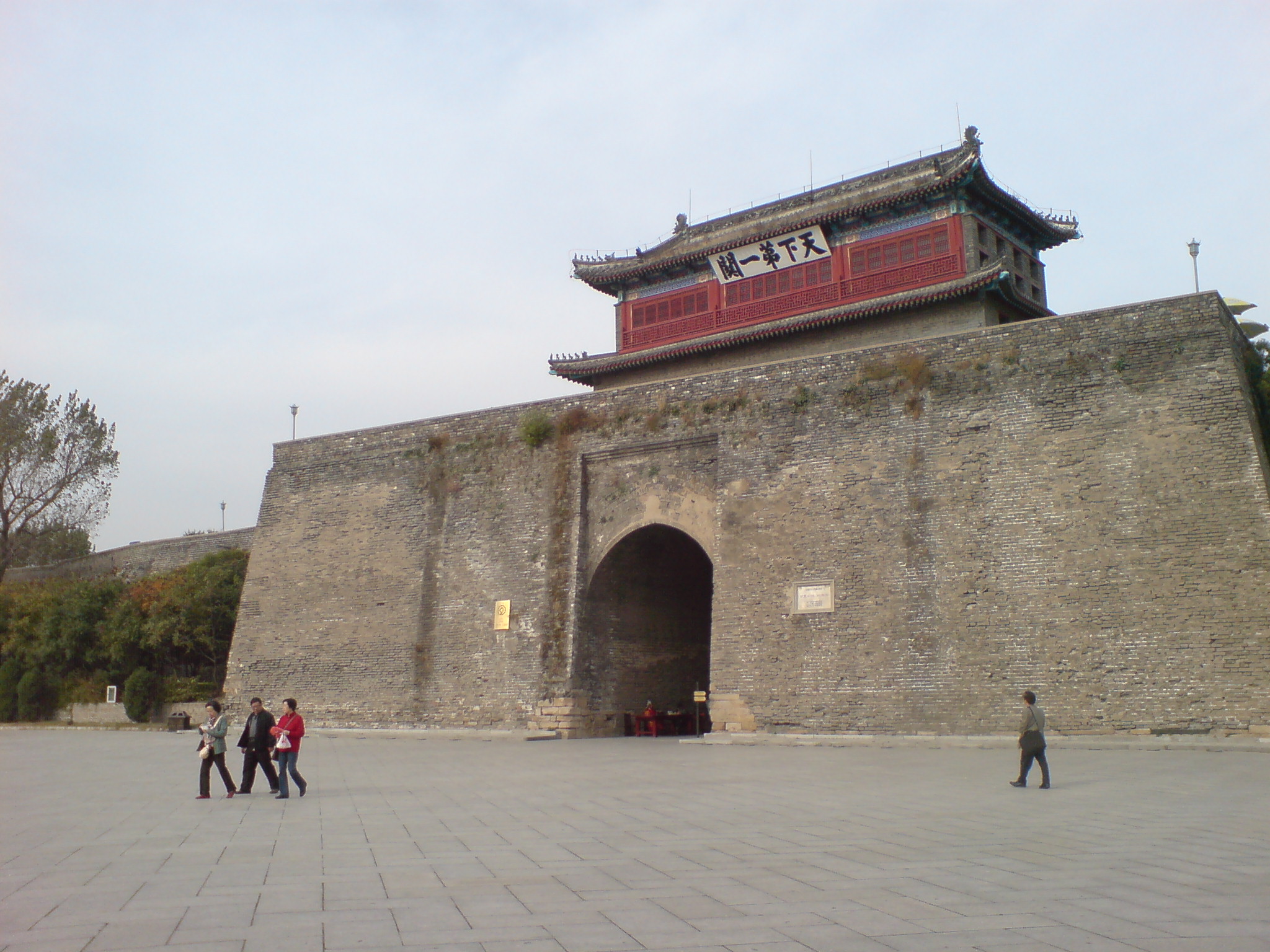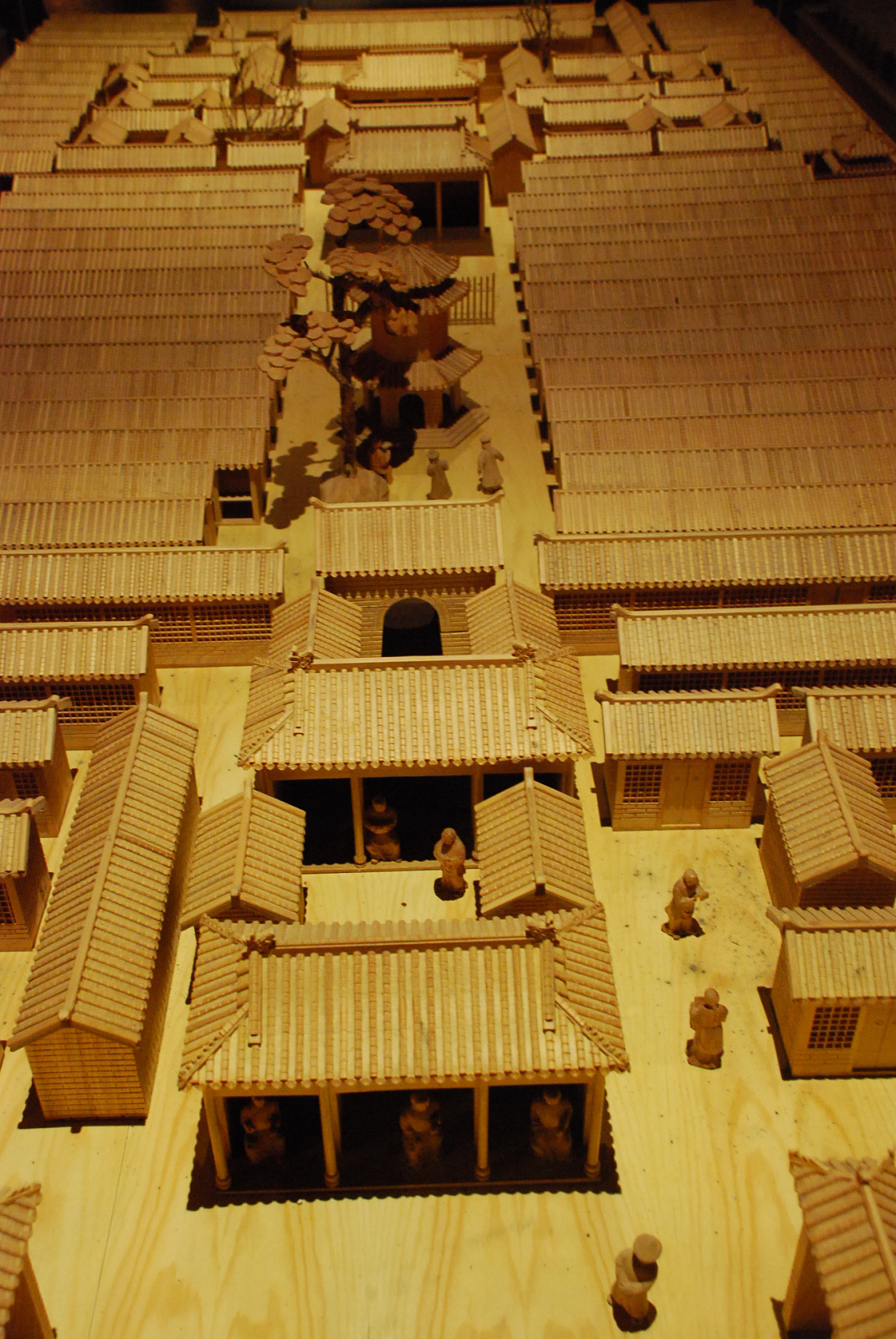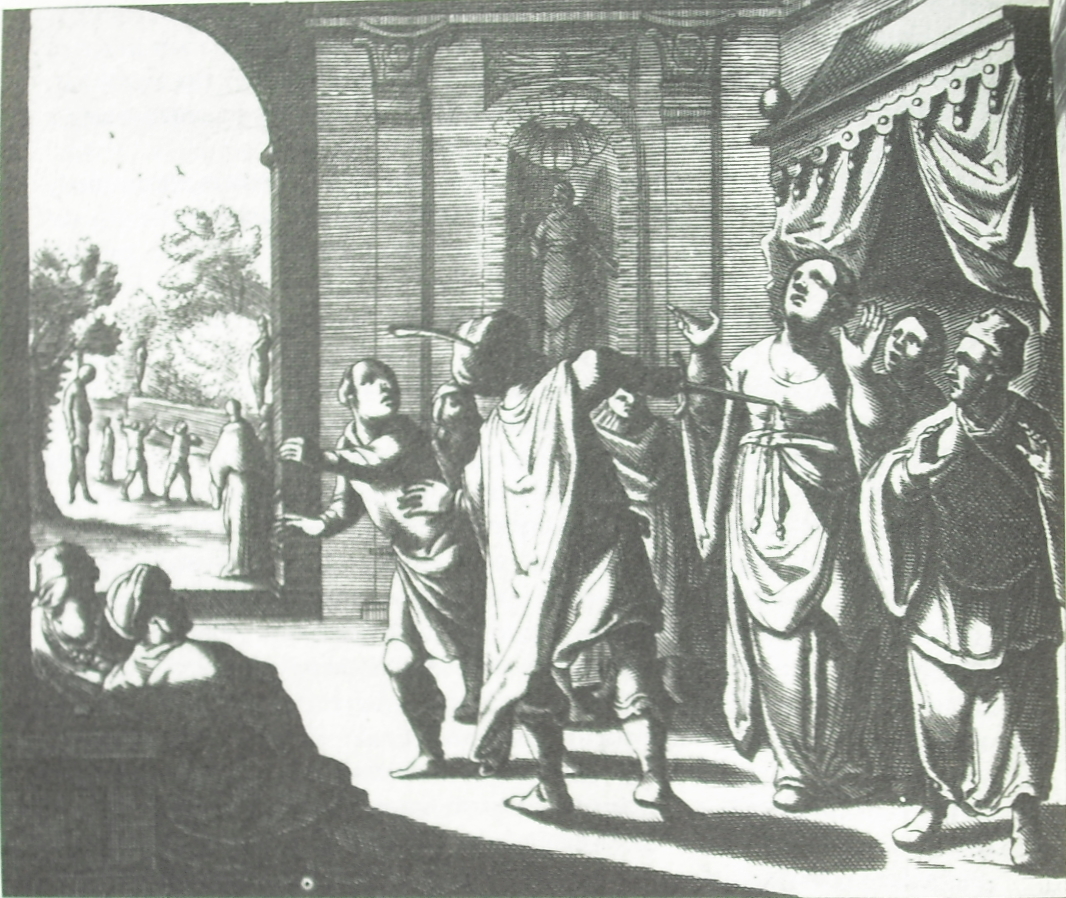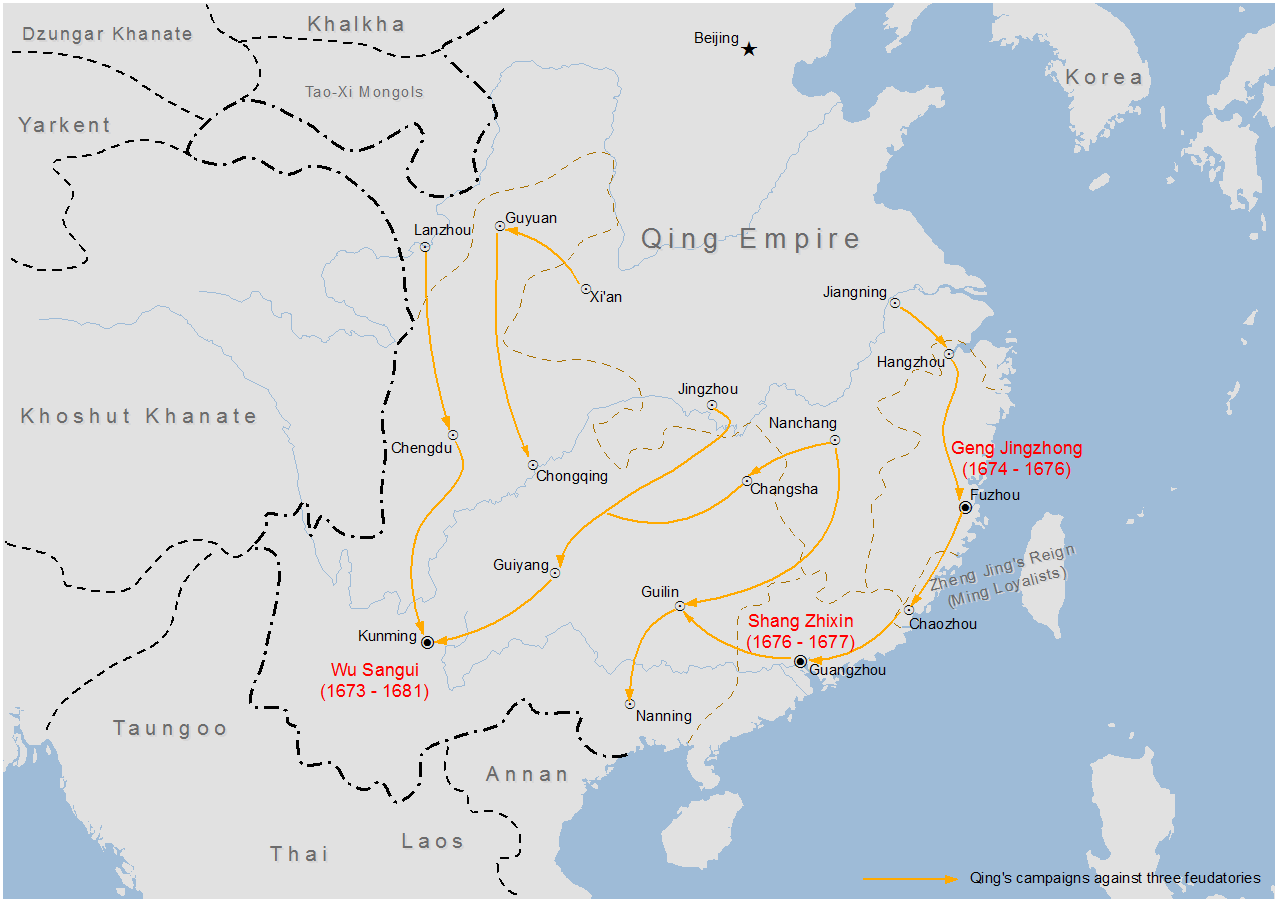|
Wu Sangui
Wu Sangui (; 8 June 1612 – 2 October 1678), courtesy name Changbai () or Changbo (), was a Chinese military leader who played a key role in the fall of the Ming dynasty and the founding of the Qing dynasty. In Chinese folklore, Wu Sangui is regarded as a disreputable Hanjian, Han Chinese traitor for his defection over to the Manchu people, Manchu invaders, suppression of the Southern Ming resistance and execution of the Zhu Youlang, Yongli Emperor. Wu eventually double-crossed both of his masters, the Ming and the Qing dynasties. In 1644, Wu was a Ming general in charge of garrisoning Shanhai Pass, the strategic choke point between Manchuria and Beijing. After learning that Li Zicheng's rebel army had conquered Beijing and captured his family, including his father Wu Xiang (Ming general), Wu Xiang and concubine Chen Yuanyuan, Wu allowed the Manchu to enter China proper through Shanhai Pass to drive Li from Beijing, where the Manchu then set up the Qing dynasty. For his aid, th ... [...More Info...] [...Related Items...] OR: [Wikipedia] [Google] [Baidu] |
Wu Shifan
Wu Shifan (); 1663–1681, was the grandson of Wu Sangui and his successor as emperor of the Zhou dynasty during the Revolt of the Three Feudatories. He was declared the ''taisun'' (太孫, lit. 'Imperial Eldest Grandson'). He was eventually surrounded and killed by Qing forces at the last Zhou stronghold at Kunming. References {{China-royal-stub 1681 deaths Qing dynasty rebels Suicides in the Qing dynasty ... [...More Info...] [...Related Items...] OR: [Wikipedia] [Google] [Baidu] |
Shanhai Pass
The Shanhai Pass () is a major fortified gateway at the eastern end of the Great Wall of China and one of its most crucial fortifications, as the pass commands the narrowest choke point in the strategic Liaoxi Corridor, an elongated coastal plain at the foothills of the Yan Mountains and the only easily traversable landway between North and Northeast China. It is located in present-day Shanhaiguan District, Qinhuangdao, Hebei province, on the east bank of the Shi River, with defensive walls stretching from the Yan Mountains all the way to the shores of the Liaodong Bay. Throughout Chinese history, garrisons around the pass served as frontline defensive outposts against raids and incursions into the North China Plain by various non- Sinitic ethnic groups from the Northeast (also known as Manchuria since the 19th century), including the Dongyi, Donghu (Xianbei and Wuhuan), Khitan and Jurchen (Manchus). The current Shanhai Pass was built during the early Ming dynasty ... [...More Info...] [...Related Items...] OR: [Wikipedia] [Google] [Baidu] |
Imperial Examination
The imperial examination was a civil service examination system in History of China#Imperial China, Imperial China administered for the purpose of selecting candidates for the Civil service#China, state bureaucracy. The concept of choosing bureaucrats by merit rather than by birth started Imperial examination in Chinese mythology, early in Chinese history, but using written examinations as a tool of selection started in earnest during the Sui dynasty (581–618), then into the Tang dynasty (618–907). The system became dominant during the Song dynasty (960–1279) and lasted for almost a millennium until its abolition during the late Qing reforms, late Qing dynasty reforms in 1905. The key sponsors for abolition were Yuan Shikai, Yin Chang and Zhang Zhidong. Aspects of the imperial examination still exist for entry into the civil service of both China and Taiwan. The exams served to ensure a common knowledge of writing, Chinese classics, and literary style among state officials. ... [...More Info...] [...Related Items...] OR: [Wikipedia] [Google] [Baidu] |
Chongzhen Emperor
The Chongzhen Emperor (6 February 1611 – 25 April 1644), personal name Zhu Youjian, courtesy name Deyue,Wang Yuan (王源),''Ju ye tang wen ji'' (《居業堂文集》), vol. 19. "聞之張景蔚親見烈皇帝神主題御諱字德約,行五,生於萬曆庚戌十二月二十四日寅時,崩於崇禎甲申三月十九日丑時。" was the 17th and last emperor of the Ming dynasty. He reigned from 1627 to 1644. " Chongzhen", the era name of his reign, means "honorable and auspicious." Zhu Youjian was son of the Taichang Emperor and younger brother of the Tianqi Emperor, whom he succeeded to the throne in 1627. He battled peasant rebellions and was not able to defend the northern frontier against the Manchu. When rebels under Li Zicheng reached the capital Beijing in 1644, he committed suicide, ending the Ming dynasty. The Manchu formed the succeeding Qing dynasty. In 1645, Zhu Yousong, who had proclaimed himself the Hongguang Emperor of the Southern Ming dynasty, gave ... [...More Info...] [...Related Items...] OR: [Wikipedia] [Google] [Baidu] |
Dong Qichang
Dong Qichang (; courtesy name Xuanzai (玄宰); 1555–1636) was a Chinese art theorist, Calligraphy, calligrapher, Painting, painter, and politician of the later period of the Ming dynasty. Life as a scholar and calligrapher Dong Qichang was a native of Huating, Shanghai, Hua Ting (located in modern-day Shanghai), the son of a teacher and somewhat precocious as a child. At 12, he passed the prefectural Civil service entrance examination and won a coveted spot at the prefectural Government school. He first took the imperial civil service exam at seventeen, but placed second to a cousin because his calligraphy was clumsy. This led him to train until he became a noted calligrapher. Once this occurred, he rose up the ranks of the imperial service passing the highest level at the age of 35. He rose to an official position with the Ministry of Rites. Qichang's calligraphy drew inspiration from prominent calligraphers Wen Zhengming and Zhao Mengfu and of the masters of the Jin dynasty ... [...More Info...] [...Related Items...] OR: [Wikipedia] [Google] [Baidu] |
Jiangsu
Jiangsu is a coastal Provinces of the People's Republic of China, province in East China. It is one of the leading provinces in finance, education, technology, and tourism, with its capital in Nanjing. Jiangsu is the List of Chinese administrative divisions by area, third smallest, but the List of Chinese administrative divisions by population, fifth most populous, with a population of 84.75 million, and the List of Chinese administrative divisions by population density, most densely populated of the 22 provinces of the People's Republic of China. Jiangsu has the highest GDP per capita and second-highest GDP of Chinese provinces, after Guangdong. Jiangsu borders Shandong in the north, Anhui to the west, and Zhejiang and Shanghai to the south. Jiangsu has a coastline of over along the Yellow Sea, and the Yangtze flows through the southern part of the province. Since the Sui dynasty, Sui and Tang dynasty, Tang dynasties, Jiangsu has been a national economic and commercial center ... [...More Info...] [...Related Items...] OR: [Wikipedia] [Google] [Baidu] |
Gaoyou
Gaoyou (), is a county-level city under the administration of Yangzhou, Jiangsu province, China, located in the Yangtze River Delta on the north side of the Yangtze River. History Recent archaeological finds at the Longqiuzhuang site in Gaoyou has found evidence of rice growing dating back 5,500-7,000 years. Gaoyou ''ting'' (commune, ) located in this area was established in Qin dynasty. Then Gaoyou county whose seat was the former commune was established in BC 118. In 1353, Zhang Shicheng revolted and captured the walled city of Gaoyou. In the next year, Zhang established Kingdom of Dazhou, while Gaoyou functioned as its temporary capital until 1356. Later, the city withstood the siege led by Toqto'a, since the complicated politics severely reduced the cohesion of the Yuan army. At that time, it was one of the 46 important mail posts along the Grand Canal between Beijing and Nanjing. It was in use until the 1911 Revolution. On 2 October 1939, the Japanese army captured the walle ... [...More Info...] [...Related Items...] OR: [Wikipedia] [Google] [Baidu] |
Emperor Of China
Throughout Chinese history, "Emperor" () was the superlative title held by the monarchs of imperial China's various dynasties. In traditional Chinese political theory, the emperor was the " Son of Heaven", an autocrat with the divine mandate to rule all under Heaven. Emperors were worshiped posthumously under an imperial cult. The lineage of emperors descended from a paternal family line constituted a dynasty, and succession in most cases theoretically followed agnatic primogeniture. The emperor of China was an absolute monarch. During the Han dynasty, Confucianism gained sanction as the official political theory. The absolute authority of the emperor came with a variety of governing duties and moral obligations; failure to uphold these was thought to remove the dynasty's Mandate of Heaven and to justify its overthrow. In practice, emperors sometimes avoided the strict rules of succession and dynasties' purported "failures" were detailed in official histories written by ... [...More Info...] [...Related Items...] OR: [Wikipedia] [Google] [Baidu] |
Revolt Of The Three Feudatories
The Revolt of the Three Feudatories, () also known as the Rebellion of Wu Sangui, was a rebellion lasting from 1673 to 1681 in the early Qing dynasty of China, during the reign of the Kangxi Emperor (r. 1661–1722). The revolt was led by Wu Sangui, Shang Zhixin and Geng Jingzhong, the three ethnic Han lords of Yunnan, Guangdong and Fujian provinces whose hereditary titles were given to them for defecting to and helping the Qing dynasty conquer China proper, who rebelled after the Qing central government started abolishing their fiefs. The feudatories were supported by Zheng Jing's Kingdom of Tungning on the island of Taiwan, which sent forces to invade Mainland China. Additionally, minor Han military figures, such as Wang Fuchen, and the Chahar Mongols, also revolted against Qing rule. Due to their history as defectors that helped to topple the Southern Ming dynasty, the Three Feudatories failed to win over the support of the general Han populace and were eventually def ... [...More Info...] [...Related Items...] OR: [Wikipedia] [Google] [Baidu] |
Guizhou
) , image_skyline = , image_caption = , image_map = Guizhou in China (+all claims hatched).svg , mapsize = 275px , map_alt = Map showing the location of Guizhou Province , map_caption = Map showing the location of Guizhou Province , coordinates = , subdivision_type = Country , subdivision_name = China , named_for = Gui - Gui Mountains ''zhou (political division), zhou'' (prefecture) , seat_type = Capital , seat = Guiyang , seat1_type = Largest city , seat1 = Zunyi , parts_type = Divisions , parts_style = para , p1 = 9 Prefectures of China, prefectures , p2 = 88 Counties of China, counties , p3 = 1539 Townships of China, townships , government_type = Provinces of China, Province , governing_body = Guizhou Provincial People's Congress , leader_title = Party Secretary of Guiz ... [...More Info...] [...Related Items...] OR: [Wikipedia] [Google] [Baidu] |
Yunnan
Yunnan; is an inland Provinces of China, province in Southwestern China. The province spans approximately and has a population of 47.2 million (as of 2020). The capital of the province is Kunming. The province borders the Chinese provinces of Guizhou, Sichuan, Autonomous regions of China, autonomous regions of Guangxi and Tibet Autonomous Region, Tibet, as well as Southeast Asian countries Myanmar (Burma), Vietnam, and Laos. Yunnan is China's fourth least developed province based on disposable income per capita in 2014. Yunnan is situated in a mountainous area, with high elevations in the Northwest and low elevations in the Southeast. Most of the population lives in the eastern part of the province. In the west, the altitude can vary from the mountain peaks to river valleys as much as . Yunnan is rich in natural resources and has the largest diversity of plant life in China. Of the approximately 30,000 species of Vascular plant, higher plants in China, Yunnan has perhaps 17, ... [...More Info...] [...Related Items...] OR: [Wikipedia] [Google] [Baidu] |
China Proper
China proper, also called Inner China, are terms used primarily in the West in reference to the traditional "core" regions of China centered in the southeast. The term was first used by Westerners during the Manchu people, Manchu-led Qing dynasty to describe the distinction between the historical "Han lands" ( zh, t=漢地, i.e. regions long dominated by the majority Han Chinese, Han population) and the "frontier" regions of China where more ethnic minorities in China, non-Han ethnic minorities and newer foreign immigrants (e.g. Russians) reside, sometimes known as "Outer China". There is no fixed extent for China ''proper'', as many administrative, cultural, and linguistic shifts have occurred in History of China, Chinese history. One definition refers to the original area of Chinese civilization, the Zhongyuan, Central Plain (in the North China Plain); another to the Eighteen Provinces of the Qing dynasty. There was no direct translation for "China ''proper''" in the Chinese ... [...More Info...] [...Related Items...] OR: [Wikipedia] [Google] [Baidu] |








